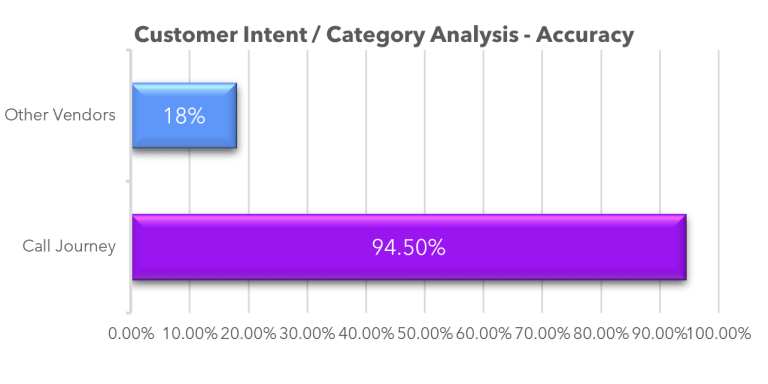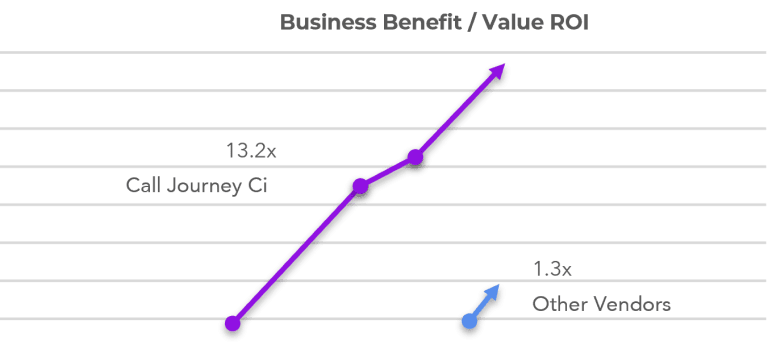Case Study
How A Leading Global Business Process Outsourcing Firm Leveraged Call Journey CI To Deliver Unique And Substantial Benefits to Their Customers
Background
In the highly competitive and challenging area of global Business Process Outsourcing, BPOs are constantly seeking innovative ways to optimize operations, meet sophisticated client requirements, and manage an environment of thin operating margins. Alongside these challenges are headwinds pressuring BPOs to add value to client partnerships whilst maintaining quality and compliance standards across global delivery models.
This case study explores how a leading global BPO utilized Call Journey CI for conversation analysis of customer conversations across voice and non-voice channels to identify and capitalize on 7 different categories for business improvement, resulting in a staggering $26 million in potential savings for their client – just over $23m of that in tangible and directly measurable client-side cost/business benefits.
The Challenge
Market Challenge
According to a 2024 McKinsey global study, companies are also looking outside their organizations for innovative ways to fill capability gaps. Outsourcing, once viewed primarily as a way to reduce costs, is increasingly seen as an effective source of additional skilled capacity and innovation capabilities. Fifty-five percent of the companies in our survey currently outsource part of their customer care operations, and 47 percent of those organizations expect to increase their outsourcing over the next two years.
Outsourcing relationships are becoming deeper too, with respondents telling us that they are now using their business process outsourcing for a range of activities that extends far beyond traditional call and email handling. They include content management and digital-marketing services, payments handling, and the development of AI-based customer care tools. Following the blueprint established by major players in the industrial products, medical device, software, and e-commerce sectors, some companies are now working with outsourcing partners to set up global innovation hubs that will drive the development of next-generation customer care technologies.
BPO Specific Challenge
The global BPO was managing a large US Fortune 500 Financial Service customer who was significantly challenged with customer loss and dissatisfaction, NPS / CSAT measures, underperforming their goal, combined with a substantial increase of complaints. Some of the angst was directed toward the BPO with the inference that the BPO operations was a key contributor to the challenge. The BPO was underperforming in a couple of key KPIs such as AHT and FCR.
Nine months out from a contract renewal period, the BPO was under pressure to both save and retain the FS customer and manage the margin threshold they were operating under. Additionally, there was pressure from the FS customer for the BPO to reduce the amount of seats through more efficient customer contact methods, i.e., GenAI bots, digitization and self-service. Although many of those customer interaction elements were out of the BPO’s control, they were still expected to find ways to contribute to the solution.
Traditional data intelligence approaches and methods such as agent disposition codes, standard topic analysis, and AI/human interaction observation was not providing the intelligence the BPO needed to validate the customer feedback.
In parallel to this, the BPO still had to maintain KPI-based obligations to the customer inclusive of agent performance insights and QA.
The almost 6,000 strong operation that the BPO was managing transversed three different continents, covering all of voice, email, chat and BOH ticket management.
To be honest, we were really struggling to find accurate data and insights to remediate our client's challenges. By accurate data, I mean qualitative and quantitative data, to quite detailed dissection levels. We were facing the real risk of losing 6,000 seats to our competitors.
Chief Commercial Officer and Head of Client Services
The Chief Commercial Officer and Head of Client Services was frustrated that the key initiatives that they were driving lacked effective intelligence, hampering the success of those initiatives.
Although we had been getting some level of dissatisfaction from our FS customer in our QBRs, we were blindsided by the performance feedback, particularly when we didn't have the data, statistics or intelligence to validate their feedback.
Chief Commercial Officer and Head of Client Services
There were a number of challenges presented by the FS customer to the BPO, which included:
- Customer Dissatisfaction – The FS client measured and assessed customer satisfaction through survey tools, revenue attrition measures, AHT overruns, interaction volumes, and FCR metrics. The inference was that the BPO experienced incompetency whilst contributing to the negative customer dissatisfaction category.
- CSAT/NPS – The FS client was aiming for a CSAT score of 80% or above and an NPS of 45 and above. They were tracking at 61% and 28 respectively.
- Complaints – Defined as where customers contacted a complaints area (voice and digital). Complaints were up 27% year on year.
- AHT/FCR – In some queues, AHT was almost 40% over guidelines and in others, FCR was in the high 50% – low 60% range.
expansion of value
Call Journey CI was already supporting the global BPO with agent-focused conversation intelligence with a predominant focus on agent performance, agent coaching, and team leader intelligence. As part of our regular partner update with our BPO customer, Call Journey outlined its expanded intelligence capability from BPO interactions with their customers. Once the BPO became aware of the new modules of capability, they moved quickly for an expanded overview with the broader BPO leadership team.
Post the overview, it was quite clear to the BPO leadership that Call Journey’s new platform could deliver unique and accurate data points and intelligence that would help validate their FS customers’ challenges. The components and functionality of the platform that the BPO saw as both significantly unique and having potential to deliver significant upside for their FS customer were as follows:
- Dissatisfaction Root Cause Analytics and Deep Multi-Layered Categorization – the BPO was super excited about the levels of insights, intelligence, and multi-layered detail that provided far more accurate analytics of dissatisfaction inclusive of both qualitative and quantitative assessment. Moreover, when running actual FSI interactions through the dissatisfaction module, it became clear that a good majority of dissatisfaction didn’t lie with the agent experience but rather overall product journey and banking self-service components.
- CSAT / NPS – The BPO as per above, when running actual FSI interactions through the platform, utilized a number of modules and points of analysis to better understand what would drive customer satisfaction and experience with the bank (via the BPO) that would likely influence NPS results. The BPO utilized Call Journey CI’s Customer Effort Score Module to exactly pinpoint and understand where customer effort was high in engaging with the bank (as per assessed from BPO customer interactions at scale). This particular module helped them understand key drivers of interaction friction, where the highest friction score was in self-service failure, followed closely by mobile app problems and loans and mortgage product complexity. Additionally, by being able to understand in full detail the factors behind exactly why customers were contacting the bank (BPO), the biggest issues found were payment issues, account balances and statements, and billing and payments where the common theme was processing errors or issues on the banking side. Lastly, they were able to drill down to exactly where neutral, mixed or negative sentiment correlated to in terms of category. For example, fraud and security as a contact category had a complaint negative, neutral or mixed sentiment of 44.96%.
- Operational Intelligence – With Call Journey CI delivering out of the box key use cases with significant relevancy, straight away the BPO was able to understand exactly why people were ACTUALLY calling, why they were dissatisfied, why their AHT was where it was and why they keep getting repeat callers. This allowed the BPO to focus on remediating exactly what the issues were with real data rather than guesswork or low-volume observations. For example, they found that unexpected fees and charges contributed to their highest AHT interactions where the AHT was almost double the average. They also found statistically that 82% of that grouping could have been solved with a better banking web interface.
- Simplicity of insights – Like most BPOs, analytics capacity was low and therefore, the BPO was looking for more data story-telling and data interpretation. With the core philosophy of Call Journey Ci’s platform being to deliver insights, summaries and recommendations from its sophisticated intelligence platform, the BPO was able to glean and share insights simply, easily and fluently with their FSI customer without having to worry about data wrangling and business analytics capacity.
Vendor Comparison

Call Journey Ci unlike all other vendors utilized far more details relevant and context-aware data mining techniques to surface things like the root cause of customer contact, the root cause of dissatisfaction, and the cause of high AHT and low FCR. All other vendors fundamentally were utilizing basic word-spotting and topic analysis which statistically showed to be surfacing inaccurate and misleading data and insights.
Before we were aware of Call Journey's new platform, we had already begun looking at vendors to help with one of our core challenges, being able to REALLY understand what drove them to contact our client (whose interactions we were already managing). When we were able to compare Call Journey's output to other vendors results, the comparison was so far in Call Journey's favor - it was staggering!
Senior VP, Data Analytics
We were hugely impressed with the outputs of Call Journey CI Uncover platform as we didn't need to lean into our own internal data or business analytics capabilities. As a BPO data leader, I have both limited capacity and specialized competency in my team to even access this sort of data, let along wrangle it! The platform did the majority of the work for us, utilizing advanced data storytelling approaches and new and unique data.
Senior VP, Data Analytics



Once we had time to be exposed to and understand Call Journey CI Uncover platform, it became abundantly obvious to us that we had just discovered a new, unique and valuable intelligence asset for both ourselves and most importantly our clients.
Chief Revenue Officer
The Methodology
How the BPO Used Call Journey Ci
The BPO decided to explore conversation intelligence as a means of extracting valuable, actionable insights from customer interactions. Leveraging advanced natural language processing technologies, advanced machine learning, and data science principals and models with Call Journey CI, the BPO benefits from a hands-off diagnostic assessment of their client’s CX problems.
Key elements/modules of the platform utilized:
- PII/PCI Redaction: Implementation of cloud-based PCI and PII redaction, ensuring that customers’ identities are protected throughout the analysis process.
- Dissatisfaction Analysis: Data science and AI/ML-driven analysis of what was truly driving dissatisfaction. Layers 4 and 5 of interaction assessments applied including the use of GenAi as a component of the solution to understand, categorize, and report on dissatisfaction. Elements include context and relativity and are achieved through qualitative and quantitative assessment.
- Root Cause Analysis – Contact Drivers: Data science and AI/ML-driven analysis of what was truly driving customers to make contact. Layers 4 and 5 of interaction assessments applied including the use of GenAi as a component of the solution to understand, categorize, and report on the key reason/s for customer contact. This is not a basic level of topic analysis common in the market to levels 1 and 2 at best – this is a comprehensive, levels 4 and 5 data-driven, precise assessment using sophisticated data science algorithms and models.
- Root Cause Analysis – Repeat Contact: Data science and AI/ML-driven analysis to a) pinpoint when a customer has made repeat contact and b) diagnose why that customer had to make repeat contact. This helps not only quantify but also qualify the factors impacting FCR.
The Results
The Results
The conversation analysis examined 2,000 agents’ interactions over a 2 week period and yielded a total of well over 100 distinct opportunities for business improvement by addressing preventable elements within the business and the contact center’s productivity to save costs. The potential savings/business benefit associated with these opportunities was estimated at $23 million in potential savings.

Outcome: A New Revenue Stream Uncovered
- Armed with the transformative insights of Call Journey Ci, the BPO was able to develop a value-adding program to deliver incredible results to their clients, including this flagship client. Their model included either per-seat or one-off engagements.
- Their flagship client was the first of many to expand their BPO arrangement to include insights-as-a-Service, increasing their processing volume with the BPO by 200%. This included their top customers and key near-term renewals.
- The BPO realized an 18% increase in per-seat revenue through the additional ‘Insights-as-a-Service’ capability.
With a constant challenge to find unique and innovative ways for us to stand out from our competitors, being able to accurately, definitively, and quantitatively provide high impact intelligence to our clients became a very compelling proposition for us. Not only would we be able to explicitly understand where the root cause of challenges sat between our own internal operation and that of our clients, but we would be able to provide our clients invaluable intelligence which they most likely don't even have themselves.
Chief Revenue Officer



